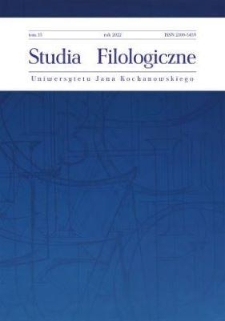Biblioteka Cyfrowa Uniwersytetu Jana Kochanowskiego udostępnia 13 273 obiektów cyfrowych
Obiekt
Tytuł: Mr. Bones’s Incredible Journey: Canine Travel and Homelessness in Paul Auster’s “Timbuktu”
Twórca:
Tytuł publikacji grupowej:
Abstrakt:
The US-American novelist Paul Auster’s Timbuktu (1999) is written in the tradition of books, films and even the popular press about traveling dogs: The Incredible Journey (novel, 1961; film, 1963; film remake, as Homeward Bound: The Incredible Journey, 1993), White God (film, 2014), and Pero, “the real-life Homeward Bound! Homesick sheepdog makes incredible 12-day 240-mile journey back to his original owner after running off from his new farmhouse” (news story, 2016). Like the dogs in these other narratives, Mr. Bones, the traveling dog in Timbuktu, has been rendered homeless, and throughout the novel he travels to find a new home. With reference to the several versions of The Incredible Journey and to White God, this paper will focus on the way canine travel is driven by homelessness in Timbuktu. But, as Mr. Bones thinks, is travel for homeless dogs in fact travel when they aren’t “going anywhere, just traveling around in circles, lost in the limbo between one nowhere and the next” (89)? When his human companion and vagabond Willy G. Christmas was alive, Mr. Bones later muses in the novel, the years they spent on the road was, indeed, “travel.” Through the perspective of Mr. Bones, Paul Auster speculates on what travel means for the homeless, both human but especially canine. As a philosophizing protagonist, Mr. Bones is, for sure, anthropomorphized, but, as Jutta Ittner argues, this is a “new anthropomorphism that views the animal as a separate and unknowable entity” (2006). Mr. Bones’s final destination is “Timbuktu,” which is what Willy G. Christmas called the “next world”: “Where the map of this world ends,” Willy told Mr. Bones, “that’s where the map of Timbuktu begins” (48). Timbuktu, which has, for centuries, resonated as the most remote part of the world, is a fitting image for Giorgio Agamben’s open, or the space shared by human and nonhuman animal consciousness. This paper will conclude with a consideration of this mental map.
Miejsce wydania:
Opis fizyczny:
ISSN:
Wydawca:
Wydawnictwo Uniwersytetu Jana Kochanowskiego w Kielcach
Data wydania:
Identyfikator:
oai:bibliotekacyfrowa.ujk.edu.pl:13662 doi:10.25951/8440
Język:
Jest częścią:
Studia Filologiczne Uniwersytetu Jana Kochanowskiego
Ma część:
Typ:
Prawa dostępu:
Kolekcje, do których przypisany jest obiekt:
- Biblioteka Cyfrowa Uniwersytetu Jana Kochanowskiego > Wydawnictwo Uniwersyteckie
- Biblioteka Cyfrowa Uniwersytetu Jana Kochanowskiego > Wydawnictwo Uniwersyteckie > Wydawnictwa ciągłe
- Biblioteka Cyfrowa Uniwersytetu Jana Kochanowskiego > Wydawnictwo Uniwersyteckie > Wydawnictwa ciągłe > „Studia Filologiczne Uniwersytetu Jana Kochanowskiego”
Data ostatniej modyfikacji:
18 gru 2025
Data dodania obiektu:
18 gru 2025
Liczba wyświetleń treści obiektu:
11
Wszystkie dostępne wersje tego obiektu:
https://bibliotekacyfrowa.ujk.edu.pl/publication/8440
Wyświetl opis w formacie RDF:
Wyświetl opis w formacie OAI-PMH:
| Nazwa wydania | Data |
|---|---|
| Dubino, Jeanne, Mr. Bones’s Incredible Journey: Canine Travel and Homelessness in Paul Auster’s “Timbuktu” | 18 gru 2025 |

